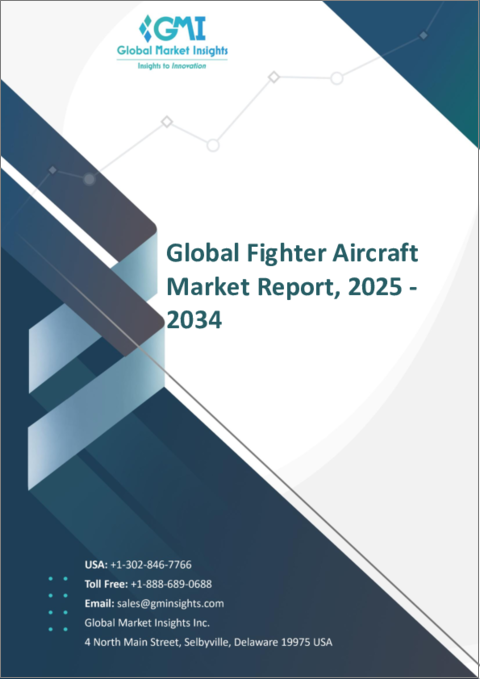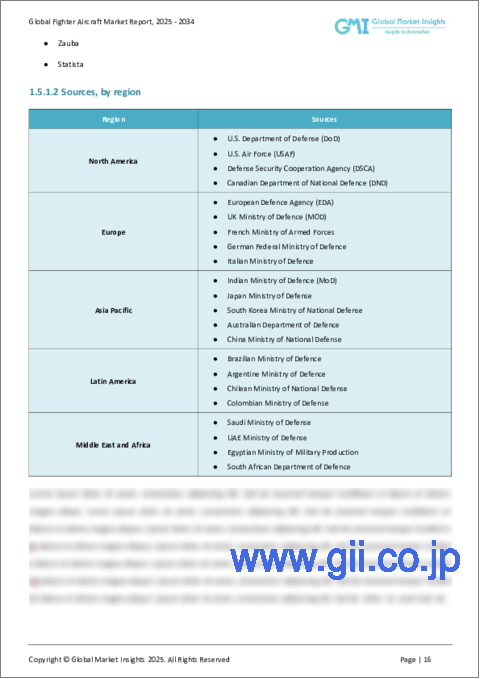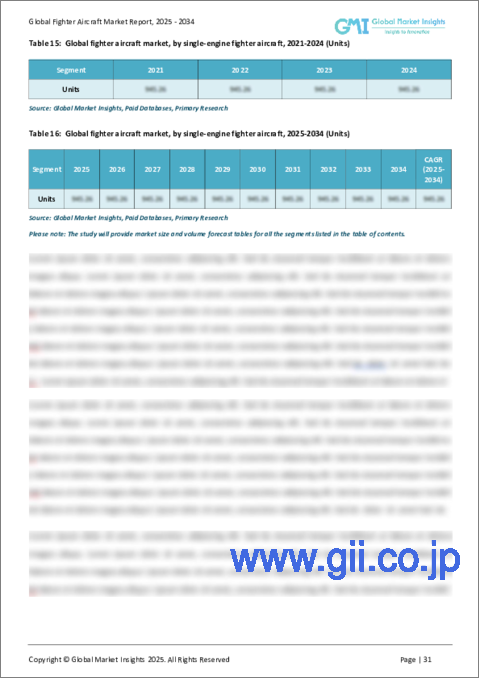|
|
市場調査レポート
商品コード
1750417
戦闘機の市場機会、成長促進要因、産業動向分析、2025年~2034年予測Fighter Aircraft Market Opportunity, Growth Drivers, Industry Trend Analysis, and Forecast 2025 - 2034 |
||||||
カスタマイズ可能
|
|||||||
| 戦闘機の市場機会、成長促進要因、産業動向分析、2025年~2034年予測 |
|
出版日: 2025年05月13日
発行: Global Market Insights Inc.
ページ情報: 英文 185 Pages
納期: 2~3営業日
|
全表示
- 概要
- 目次
世界の戦闘機市場は、2024年には508億米ドルとなり、CAGR4.1%で成長し、2034年までには751億米ドルに達すると推定されています。
この成長は、防衛予算の増加と近代的な戦闘機の調達増加によるところが大きいです。空中戦闘能力のアップグレードが重視されるようになり、無人戦闘機(UCAV)のような次世代技術への注目が高まっていることが、堅調な需要に寄与しています。防衛軍は幅広い任務を遂行できる先進的な航空機に重点を移しつつあり、各国政府は将来の紛争で優位に立つためにステルス機能、改良型アビオニクス、デジタル戦争ツールに投資しています。戦闘機は、国家安全保障の枠組みにおいて引き続き重要な要素であり、調達戦略は現在、柔軟性、生存性、任務の多様性を実現するプラットフォームを優先しています。

航空宇宙産業は、特に過去の政策転換や貿易の混乱により、さまざまな課題に直面してきました。航空宇宙部品に課された関税と国際貿易紛争は、サプライチェーン全体にコスト圧力をもたらしました。これらの関税はメーカーの製造コストを引き上げ、推進システム、アビオニクス、レーダー技術などの必須部品の調達を混乱させました。これに対し、航空機メーカーは、より弾力的なサプライチェーン戦略を採用し、現地調達を拡大することで調整しました。こうした対策により、重要部品の継続的な供給が確保され、経済の緊張にもかかわらず生産の勢いが維持されました。今日、サプライチェーンはより多様化し、国際貿易力学の変動を吸収できる体制が整っています。
| 市場範囲 | |
|---|---|
| 開始年 | 2024年 |
| 予測年 | 2025年~2034年 |
| 開始金額 | 508億米ドル |
| 予測金額 | 751億米ドル |
| CAGR | 4.1% |
離着陸能力の観点から、市場は短距離離着陸(STOVL)、従来型離着陸(CTOL)、垂直離着陸(VTOL)に区分されます。2024年の市場シェアはCTOLが47.3%と圧倒的でした。この分野は、標準的な滑走路との互換性が高く、より複雑な垂直離着陸システムと比べて技術的な要求が少ないことが主な理由で、引き続き好調に推移しています。最新のCTOL航空機は、ステルス技術、マルチロール機能、航続距離延長機能でアップグレードされています。このようなアップグレードにより、さまざまなミッションに対応できるようになる一方、運用コストやメンテナンスコストは長期的に削減されます。
推進力に基づき、市場は単発エンジンと双発エンジンの戦闘機に分類されます。シングルエンジンの戦闘機セグメントは、2034年までに408億米ドルに達すると予想されています。これらの航空機は、コスト効率、軽量化、メンテナンスの容易さから、ますます好まれるようになっています。国防予算が限られている国や、迅速な対応が可能なプラットフォームを求める国は、航空警察やマルチロールミッションのために単発戦闘機に目を向けています。設計の進歩により、これらの航空機はステルス機能、データリンク機能、優れたアビオニクスシステムを組み込むことが可能になり、幅広いユーザーにとって手頃な価格で戦闘効果の高い選択肢となっています。
用途別には、打撃・対地攻撃、電子戦、偵察・監視、制空権、その他の役割があります。攻撃または対地攻撃分野は、予測期間中にCAGR3.8%で成長すると予測されています。この成長は、精密誘導兵器、AI対応照準ツール、改良された生存性機能の統合の増加によって促進されます。最新の攻撃型航空機は、複数の任務を効率的に遂行するために開発されており、空対地と空対空の役割間の迅速な移行を提供しています。このような機能強化により、脅威への露出を最小限に抑えながら、ミッションの適応性を高めることができます。
米国は引き続き世界市場で最大のシェアを占めており、2024年には87.9%を占めました。そのリーダーシップは、積極的な近代化プログラムとネットワーク中心戦争への強い焦点に支えられています。第6世代技術への投資と現有艦隊の強化が、戦闘戦略を再構築しています。また、相互運用性とデジタル戦争を優先させることで、世界の航空宇宙情勢における戦略的地位を強化しています。
戦闘機業界の競合は熾烈で、大手企業は合計で25%以上の市場シェアを獲得しています。これらの企業は、統合電子戦システム、AI機能、デジタル設計プロセスを通じてイノベーションを推進しています。市場は、研究開発投資の共有と配備スケジュールの迅速化を促進する多国間開発プログラムの増加傾向を目の当たりにしています。戦略的な協力関係は、現代の戦闘における複雑な要求を満たすために不可欠になりつつあり、輸出志向の調達戦略は多くの国にとって市場範囲を拡大しています。
また、特にアジアの新興防衛生産国の間では、航空機プラットフォームの国産化に向けたシフトが顕著になっています。これらの国々は、外国メーカーへの依存度を下げ、技術的な自立を高めることを目指しています。同時にメーカー各社は、顧客との関係を深め、継続的な収益を確保するために、長期保守契約やライフサイクルサービス契約を重視しています。こうしたアプローチは、世界の防衛市場において、性能、手頃な価格、持続的なパートナーシップを中心とした、ダイナミックでイノベーション主導のエコシステムの構築に役立っています。
目次
第1章 調査手法と範囲
第2章 エグゼクティブサマリー
第3章 業界考察
- 業界エコシステム分析
- トランプ政権の関税分析
- 貿易への影響
- 貿易量の混乱
- 報復措置
- 業界への影響
- 供給側の影響(原材料)
- 主要原材料の価格変動
- サプライチェーンの再構築
- 生産コストへの影響
- 需要側の影響(販売価格)
- 最終市場への価格伝達
- 市場シェアの動向
- 消費者の反応パターン
- 供給側の影響(原材料)
- 影響を受ける主要企業
- 戦略的な業界対応
- サプライチェーンの再構成
- 価格設定と製品戦略
- 政策関与
- 展望と今後の検討事項
- 貿易への影響
- 業界への影響要因
- 成長促進要因
- 地政学的緊張の高まりと防衛の近代化
- 防衛費の増加が調達を促進
- 多用途戦闘機と次世代戦闘機の需要の高まり
- 国産航空機開発プログラムの拡大
- 無人戦闘航空機(UCAV)への重点強化
- 業界の潜在的リスク・課題
- 高い初期投資と改修コスト
- 厳格な規制基準と認証の遅延
- 成長促進要因
- 成長可能性分析
- 規制情勢
- テクノロジーの情勢
- 将来の市場動向
- ギャップ分析
- ポーター分析
- PESTEL分析
第4章 競合情勢
- イントロダクション
- 企業の市場シェア分析
- 主要市場企業の競合分析
- 競合ポジショニングマトリックス
- 戦略ダッシュボード
第5章 市場推計・予測:離着陸能力別、2021年~2034年
- 主要動向
- 従来型離着陸(CTOL)
- 短距離離陸垂直着陸(STOVL)
- 垂直離着陸(VTOL)
第6章 市場推計・予測:推進方式別、2021年~2034年
- 主要動向
- 単発エンジン戦闘機
- 双発エンジン戦闘機
第7章 市場推計・予測:用途別、2021年~2034年
- 主要動向
- 打撃/地上攻撃
- 電子戦(EW)
- 偵察・監視
- 制空権
- その他
第8章 市場推計・予測:地域別、2021年~2034年
- 主要動向
- 北米
- 米国
- カナダ
- 欧州
- ドイツ
- 英国
- フランス
- スペイン
- イタリア
- オランダ
- アジア太平洋
- 中国
- インド
- 日本
- オーストラリア
- 韓国
- ラテンアメリカ
- ブラジル
- メキシコ
- アルゼンチン
- 中東・アフリカ
- サウジアラビア
- 南アフリカ
- アラブ首長国連邦
第9章 企業プロファイル
- Airbus
- BAE Systems
- Boeing
- Dassault Aviation
- Hindustan Aeronautics
- Korea Aerospace Industries
- Leonardo
- Lockheed Martin
- Mitsubishi Heavy Industries
- Northrop Grumman
- Saab
- Textron Aviation
- United Aircraft
The Global Fighter Aircraft Market was valued at USD 50.8 billion in 2024 and is estimated to grow at a CAGR of 4.1% to reach USD 75.1 billion by 2034. This growth is largely driven by rising defense budgets and growing procurement of modern combat aircraft. Increasing emphasis on upgrading aerial combat capabilities and the rising focus on next-generation technologies like unmanned combat aerial vehicles (UCAVs) are contributing to the steady demand. Defense forces are shifting their focus to advanced aircraft capable of performing a wide range of missions, while governments are investing in stealth capabilities, improved avionics, and digital warfare tools to gain an edge in future conflicts. Fighter aircraft continue to be a critical component of national security frameworks, and procurement strategies are now prioritizing platforms that deliver flexibility, survivability, and mission versatility.

The industry has faced its share of challenges, especially due to policy shifts and trade disruptions in previous years. Tariffs imposed on aerospace components and international trade disputes created cost pressures across the supply chain. These tariffs raised production expenses for manufacturers and disrupted sourcing for essential parts such as propulsion systems, avionics, and radar technologies. In response, aircraft producers adjusted by adopting more resilient supply chain strategies and expanding local sourcing. These measures helped to ensure the continued availability of vital components, preserving the production momentum despite economic tensions. Today, supply chains are more diversified and better positioned to absorb fluctuations in international trade dynamics.
| Market Scope | |
|---|---|
| Start Year | 2024 |
| Forecast Year | 2025-2034 |
| Start Value | $50.8 Billion |
| Forecast Value | $75.1 Billion |
| CAGR | 4.1% |
In terms of take-off and landing capabilities, the market is segmented into short take-off and vertical landing (STOVL), conventional take-off and landing (CTOL), and vertical take-off and landing (VTOL). CTOL fighter aircraft held a dominant 47.3% market share in 2024. This segment continues to perform strongly, largely due to its compatibility with standard runways and reduced technical demands compared to more complex vertical take-off systems. Modern CTOL aircraft are being upgraded with stealth technology, multi-role functions, and extended range capabilities. These upgrades make them suitable for a variety of missions while reducing operational and maintenance costs over time.
Based on propulsion, the market is categorized into single-engine and twin-engine fighter aircraft. The single-engine fighter aircraft segment is expected to reach USD 40.8 billion by 2034. These aircraft are increasingly favored for their cost efficiency, lighter weight, and ease of maintenance. Nations with constrained defense budgets and those looking for rapid-response platforms are turning to single-engine fighters for air policing and multi-role missions. Advances in design have enabled these aircraft to incorporate stealth features, data-link capabilities, and superior avionics systems, making them both affordable and combat-effective options for a broad range of users.
By application, the market includes strike or ground attack, electronic warfare, reconnaissance and surveillance, air superiority, and other roles. The strike or ground attack segment is anticipated to grow at a CAGR of 3.8% over the forecast period. This growth is fueled by increased integration of precision-guided weaponry, AI-enabled targeting tools, and improved survivability features. Modern strike aircraft are being developed to perform multiple mission types efficiently, offering rapid transitions between air-to-ground and air-to-air roles. These enhancements allow for greater mission adaptability while minimizing exposure to threats.
The United States continues to hold the largest share of the global market, accounting for 87.9% in 2024. Its leadership is anchored in aggressive modernization programs and a strong focus on network-centric warfare. Investment in sixth-generation technologies and enhancements to current fleets are reshaping combat strategies. The country's prioritization of interoperability and digital warfare is also reinforcing its strategic position in the global aerospace landscape.
Competition in the fighter aircraft industry is fierce, with leading players capturing a combined market share of over 25%. These companies are driving innovation through integrated electronic warfare systems, AI capabilities, and digital design processes. The market is witnessing a growing trend of multinational development programs that promote shared R&D investments and fast-track deployment timelines. Strategic collaborations are becoming critical for meeting the complex demands of modern combat, while export-oriented procurement strategies are expanding the market reach for many countries.
There is also a noticeable shift among emerging defense producers, particularly in Asia, toward domestically developed aircraft platforms. These nations are aiming to reduce their dependency on foreign manufacturers and boost technological self-reliance. At the same time, manufacturers are emphasizing long-term maintenance contracts and lifecycle service agreements to deepen customer engagement and secure recurring revenue. These approaches are helping to create a dynamic, innovation-driven ecosystem that is centered on performance, affordability, and sustained partnerships across global defense markets.
Table of Contents
Chapter 1 Methodology and scope
- 1.1 Market scope and definitions
- 1.2 Research design
- 1.2.1 Research approach
- 1.2.2 Data collection methods
- 1.3 Base estimates and calculations
- 1.3.1 Base year calculation
- 1.3.2 Key trends for market estimation
- 1.4 Forecast model
- 1.5 Primary research and validation
- 1.5.1 Primary sources
- 1.5.2 Data mining sources
Chapter 2 Executive summary
- 2.1 Industry 360° synopsis
Chapter 3 Industry insights
- 3.1 Industry ecosystem analysis
- 3.2 Trump administration tariffs analysis
- 3.2.1 Impact on trade
- 3.2.1.1 Trade volume disruptions
- 3.2.1.2 Retaliatory measures
- 3.2.2 Impact on the industry
- 3.2.2.1 Supply-side impact (raw materials)
- 3.2.2.1.1 Price volatility in key materials
- 3.2.2.1.2 Supply chain restructuring
- 3.2.2.1.3 Production cost implications
- 3.2.2.2 Demand-side impact (selling price)
- 3.2.2.2.1 Price transmission to end markets
- 3.2.2.2.2 Market share dynamics
- 3.2.2.2.3 Consumer response patterns
- 3.2.2.1 Supply-side impact (raw materials)
- 3.2.3 Key companies impacted
- 3.2.4 Strategic industry responses
- 3.2.4.1.1 Supply chain reconfiguration
- 3.2.4.1.2 Pricing and product strategies
- 3.2.4.1.3 Policy engagement
- 3.2.5 Outlook and future considerations
- 3.2.1 Impact on trade
- 3.3 Industry impact forces
- 3.3.1 Growth drivers
- 3.3.1.1 Rising geopolitical tensions and defense modernization
- 3.3.1.2 Increase in defense spending fuelling fighter aircraft procurement
- 3.3.1.3 Growing demand for multirole and next-generation fighters
- 3.3.1.4 Expansion of indigenous aircraft development programs
- 3.3.1.5 Increased focus on unmanned combat aerial vehicles (UCAVs)
- 3.3.2 Industry pitfalls and challenges
- 3.3.2.1 High initial investment and retrofit costs
- 3.3.2.2 Stringent regulatory standards and certification delays
- 3.3.1 Growth drivers
- 3.4 Growth potential analysis
- 3.5 Regulatory landscape
- 3.6 Technology landscape
- 3.7 Future market trends
- 3.8 Gap analysis
- 3.9 Porter's analysis
- 3.10 Pestel analysis
Chapter 4 Competitive landscape, 2024
- 4.1 Introduction
- 4.2 Company market share analysis
- 4.3 Competitive analysis of major market players
- 4.4 Competitive positioning matrix
- 4.5 Strategy dashboard
Chapter 5 Market Estimates & Forecast, By Take-off and Landing Capability, 2021-2034 (USD Billion & Units)
- 5.1 Key trends
- 5.2 Conventional take-off and landing (CTOL)
- 5.3 Short take-off and vertical landing (STOVL)
- 5.4 Vertical take-off and landing (VTOL)
Chapter 6 Market Estimates & Forecast, By Propulsion Type, 2021-2034 (USD Billion & Units)
- 6.1 Key trends
- 6.2 Single-engine fighter aircraft
- 6.3 Twin-engine fighter aircraft
Chapter 7 Market Estimates & Forecast, By Application, 2021-2034 (USD Billion & Units)
- 7.1 Key trends
- 7.2 Strike / ground attack
- 7.3 Electronic warfare (ew)
- 7.4 Reconnaissance & surveillance
- 7.5 Air superiority
- 7.6 Others
Chapter 8 Market Estimates and Forecast, By Region, 2021 – 2034 (USD Billion & Units)
- 8.1 Key trends
- 8.2 North America
- 8.2.1 U.S.
- 8.2.2 Canada
- 8.3 Europe
- 8.3.1 Germany
- 8.3.2 UK
- 8.3.3 France
- 8.3.4 Spain
- 8.3.5 Italy
- 8.3.6 Netherlands
- 8.4 Asia Pacific
- 8.4.1 China
- 8.4.2 India
- 8.4.3 Japan
- 8.4.4 Australia
- 8.4.5 South Korea
- 8.5 Latin America
- 8.5.1 Brazil
- 8.5.2 Mexico
- 8.5.3 Argentina
- 8.6 Middle East and Africa
- 8.6.1 Saudi Arabia
- 8.6.2 South Africa
- 8.6.3 UAE
Chapter 9 Company Profiles
- 9.1 Airbus
- 9.2 BAE Systems
- 9.3 Boeing
- 9.4 Dassault Aviation
- 9.5 Hindustan Aeronautics
- 9.6 Korea Aerospace Industries
- 9.7 Leonardo
- 9.8 Lockheed Martin
- 9.9 Mitsubishi Heavy Industries
- 9.10 Northrop Grumman
- 9.11 Saab
- 9.12 Textron Aviation
- 9.13 United Aircraft





